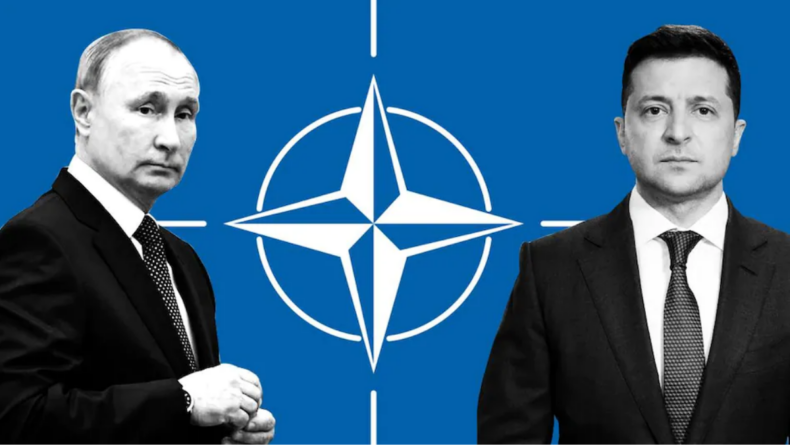Ukraine is not receiving meaningful support from NATO. This unsettling truth about the organization has been confirmed by Ukrainian President Volodymyr Zelenskyy.
After announcing the strike on state television, Russia launched a full-scale invasion on Ukraine, which was formerly a part of them, claimed the attack was to protect separatists in the east from “genocide.”
Putin has long emphasized his ambition to reintegrate Ukraine into Russia. The only thing that pushed Putin over the edge was Ukraine’s developing ties to the West, as NATO continues to expand eastward around Russia’s borders.
A threat to Russia
NATO is a military organisation founded in 1949 by the United States and many Western countries to provide collective security to its partners. The organisation was founded after WWII to limit the Soviet Union’s sphere of influence.
NATO’s twelve original members were the United States, the United Kingdom, Canada, Luxemburg, the Netherlands, Belgium, Denmark, France, Iceland, Italy, Norway, and Portugal.
In response to NATO, Soviet Russia formed the Warsaw Pact, a military alliance of eastern European communist countries, in 1955. After the Soviet Union fell apart in 1991, a number of former Warsaw Pact countries switched sides and joined NATO.
There are now 30 members in the alliance. NATO first offered Ukraine membership in 2008, and following Russia’s takeover of Crimea in 2014, Ukraine made NATO membership a top priority.
However, this has not occurred, owing to Russia’s long-standing hostility to such a move. Ukraine is not a member of NATO at the moment, but it is a partner country.
According to NATO, “any other European state in a position to further the principles of this treaty and to contribute to the security of the North Atlantic area.” It is dedicated to resolving conflicts in a peaceful manner. It has the military power to conduct crisis-management operations if diplomatic attempts fail.
On the other hand, Russia, on the other hand, wants assurances from the West that Ukraine will never be admitted to NATO. Ukraine is now a “partner country,” which means it will be able to join the military alliance at some point.
The Kremlin claims that NATO is being used by the West to expand on Russia and wants NATO to stop its military activities in eastern Europe. The Russian president has described NATO’s expansion as dangerous, and the possibility of Ukraine joining the alliance as a major threat. As Russia has become more assertive and more militarily strong, its fears about NATO have become even more strong.
It’s role amidst the Russia-Ukraine crisis
After Russia invaded Ukraine, NATO said it criticised Russia in the strongest possible terms. NATO has not sent any troops to Ukraine.
This is due to the fact that Ukraine is not a full member of NATO, which means it is not compelled to start an armed operation against Russia in order to safeguard Ukraine. Despite several warnings of impending war as a result of their expansion, they continue to expand.
A NATO member country would have to defend itself against a Russian attack if Article 5, the collective defence commitment, was used. NATO would send its own troops to the country to protect it.
If NATO invokes Article 5, which promises “collective defence,” an attack on one ally will be deemed an attack on all allies, and the crisis might likely escalate. This could happen if Russia turns its attention to some of Ukraine’s NATO-member neighbours.
But this time, Article 5 has not been invoked since Ukraine is a Western defence alliance partner but not a NATO member. While NATO has stated that it will not send soldiers to Ukraine, it has invoked Article 4, which requires the alliance’s main decision-making body, the North Atlantic Council, to discuss.
To deny Russia air dominance and protect civilians, NATO has rejected declaring a no-fly zone over Ukraine. It wants to avert a battle between its air force and Russia’s.
However, the United States and its western allies refuse to expel Ukraine from NATO, claiming that it is a sovereign country with the right to choose its own security alliances.
Russian President Vladimir Putin argues that the United States violated one 1990 security agreement that said NATO would not expand eastward.
NATO, on the other hand, has refuted these assertions, claiming that it is a defensive alliance. After Moscow began a full-scale invasion of Ukraine, the Ukrainian military has been left to battle Russian troops on its own.
NATO members have indicated that they will not intervene militarily in Ukraine. Troops were withdrawn from Ukraine and stationed in NATO member states, allowing Russia to pursue its military objectives in Ukraine with relative ease.
NATO is failing to do its job to maintain peace and resolve any crisis.
NATO and its previous failures
In its post-Cold War incarnation, NATO began militarily intervening in nations such as Kuwait, Bosnia and Herzegovina, and Yugoslavia. In the aftermath of the 9/11 attacks on the United States, it made its most significant participation in the Afghan conflict. Regrettably, it proved to be the biggest failure.
Several NATO states, on the other hand, have been supplying weapons to Ukraine to aid in its defence against Russia. Other NATO countries have also been authorised to supply Ukraine with US-made weapons.
The United States has pledged to send more troops to Europe, but President Biden has stated that they would not fight in Ukraine.
The outcome is the same whether there is a war or economic sanctions. The citizens of a country that has little power are the ones who suffer the most.
Published By : Revathy G Sanal
Edited By : Subbuthai Padma













